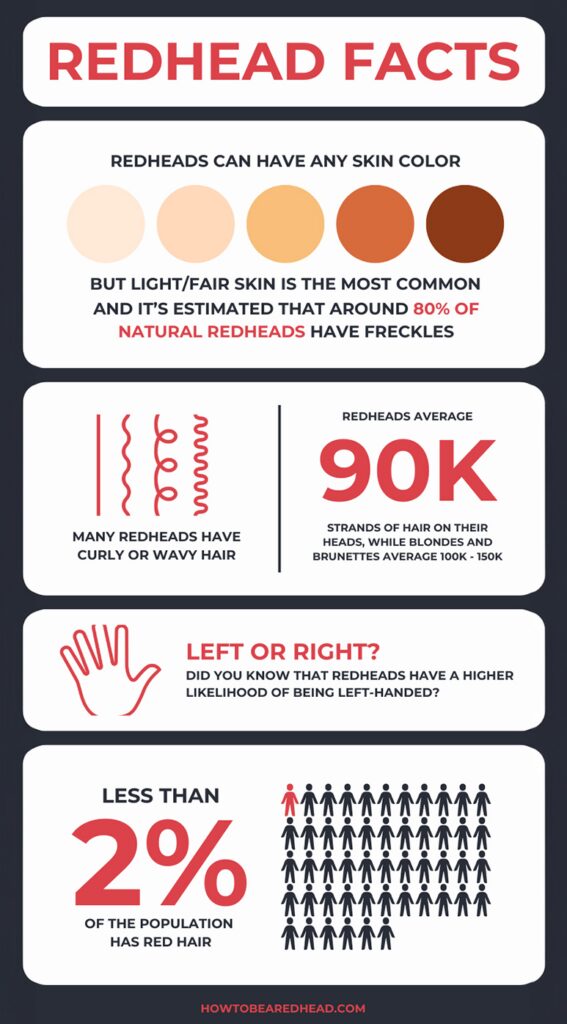Every week, we put out a call for your redhead questions. This gives you a chance to get advice or input from our team of redheads. From beauty and fashion to lifestyle, redheads are in a unique boat, and we want to help make this community a place where you can turn for all your redhead needs.
This week we had a few questions regarding the “redhead gene”, and how redheads differ genetically from those without red hair. So let’s break it down:
What is the redhead or “ginger” gene?
The “redhead gene” refers to a genetic variant called MC1R (melanocortin 1 receptor) that is associated with red hair, fair skin, and freckles. This gene is involved in determining pigmentation in hair and skin by influencing the production of melanin. Variations in the MC1R gene can result in different hair colors, with the recessive alleles often leading to red hair.
Chromosome 16 is one of the 23 pairs of chromosomes in humans. It contains around 900 to 1,200 genes and represents approximately 2.9% of the total DNA in cells. The MC1R gene, which stands for melanocortin 1 receptor gene, is located on chromosome 16. Variations in this gene can influence pigmentation traits such as hair color, skin color, and susceptibility to sunburn.
The MC1R gene plays a role in determining the pigmentation of hair, skin, and eye color. The chemical pigmentation is called melanin. There are two types of melanin, eumelanin which creates darker pigments like black and brown, and pheomelanin which creates lighter pigments like red and yellow. Redheads usually have high levels of pheomelanin and low levels of eumelanin, which is why redheads often have fair skin and light eyes.
Common traits redheads share
Aside from just red hair, there are also some other common traits that redheads may have in common. Even though redheads can come from any part of the world and any ethnic background, it’s far more common for redheads to have fair skin. It’s also quite common for redheads to have freckles, which is another trait controlled by the MC1R gene.
Redheads often have thick hair, due to the fact that they have thicker hair strands than blondes or brunettes, regardless of having fewer individual strands of hair on their heads. The MC1R gene may also be the reason many redheads have curly/wavy hair. Redheads have a higher likelihood of being left-handed than blondes or brunettes and are also more likely to have sensitive skin.

Genetic advantages + disadvantages of having red hair
Natural red hair, often associated with variations in the MC1R gene, can come with both advantages and disadvantages. Some advantages are that redheads produce the same amount of vitamin D in a shorter amount of time than others can. This is beneficial because vitamin D deficiency can be linked to diabetes and arthritis. Additionally, studies suggest that redheads have a higher threshold for pain than other hair colors. Some of the disadvantages redheads face because of their genes are an increased risk of skin cancer, as well as an increased risk of Parkinsons and endometriosis for female redheads. Redheads may also need more anesthesia than other hair colors. Let’s take a look at these plus more:
Advantages:
1. Sunlight Absorption: Red hair and fair skin allow for more efficient absorption of sunlight, aiding in the production of vitamin D, particularly in regions with lower sunlight exposure.
2. Vitamin D Synthesis: Despite the increased risk of sunburn, fair-skinned individuals with red hair may synthesize vitamin D more efficiently due to their ability to absorb sunlight.
3. Novelty and Attractiveness: In some cultures, red hair is considered unique and attractive, potentially providing social advantages.
4. Potential Health Benefits: Some studies suggest that redheads may have a higher pain tolerance and may respond differently to anesthesia, potentially offering advantages in certain medical situations.
Disadvantages:
1. Sun Sensitivity: Fair skin and red hair are more susceptible to sunburn and skin damage from UV radiation, increasing the risk of skin cancer.
2. Vitamin D Deficiency: In regions with limited sunlight, individuals with fair skin and red hair may be more prone to vitamin D deficiency.
3. Social Stigma: Red hair has historically been associated with stereotypes and discrimination in some cultures, leading to social challenges for individuals with red hair.
4. Increased Risk of Skin Cancer: The combination of fair skin and red hair increases the risk of developing skin cancer, particularly melanoma, due to decreased protection from UV radiation.
Want your redhead question answered? Find us @howtobearedhead on Instagram and Facebook and look for the Ask a Redhead question box.
Rock it like a Redhead!
RELATED POSTS
READ: Ask a Redhead: Feeling Pressured To Tan And How To Embrace Your Skin
READ: Ask a Redhead: The Complicated Feelings Around Not Having Redhead Kids



